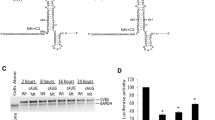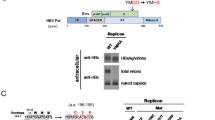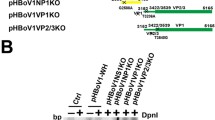Abstract
An infectious clone (pBR-XJ160) was constructed using the full-length cDNA of the Sindbis-like XJ-160 virus. Two nucleotide mutations, causing amino acid changes at residue 169 from Lys to Arg and at residue 173 from Thr to Ile in the nonstructural protein (nsP) 1 coding region, strongly influenced the infectivity of in vitro-synthesized RNA. We used site-directed mutagenesis to obtain clones encoding a change to Arg at residue 169 of nsP1 (pBR-169), a change to Ile at residue 173 (pBR-173), or both changes (pBR-6973). Infectivity of RNA from pBR-169 was abolished, but viral forms BR-173 and BR-6973 were obtained from pBR-173 and pBR-6973, respectively. Further, BR-173 exhibited higher propagation than BR-XJ160 in cell culture and higher neurovirulence in a suckling mouse model. BR-6973 possessed an intermediate phenotype. BR-173 and BR-6973 showed increased sensitivity to 3-deazaadenosine (3-DZA), which inhibits S-adenosylhomocysteine hydrolase. Thus, mutagenesis at residue 169 in the nsP1 region of XJ-160 is lethal, but mutation at residue 173 from Thr to Ile enhances viral infectivity and neurovirulence and suppresses the lethal effect of the mutation at residue 169. These mutations might be associated with the RNA methyltransferase (MTase) activity of nsP1.






Similar content being viewed by others
References
Ahlquist P, Strauss EG, Rice CM, Strauss JH, Haseloff J, Zimmern D (1985) Sindbis virus protein nsP1 and nsP2 contain homology to nonstructural proteins from several RNA plant viruses. J Virol 53:536–542
Ahola T, Laakkonen P, Vihinen H, Kääriäinen L (1997) Critical residues of Semliki Forest virus RNA capping enzyme involved in methyltransferase and guanylyltransferase-like activities. J Virol 71:392–397
Fayzulin R, Frolov I (2004) Changes of the secondary structure of the 5′ end of the Sindbis virus genome inhibit virus growth in mosquito cells and lead to accumulation of adaptive mutation. J Virol 78:4953–4964
Hahn YS, Strauss EG, Strauss JH (1989) Mapping of RNA- temperature-sensitive mutants of Sindbis virus: assignment of complementation groups A, B and G to nonstructural proteins. J Virol 63:3142–3150
Heise MT, White LJ, Simpson DA, Leonard C, Bernard KA, Meeker RB, Johnston RE (2003) An attenuating mutation in nsP1 of the Sindbis-group virus S.A.AR86 accelerates nonstructural protein processing and up-regulates viral 26S RNA synthesis. J Virol 77:1149–1156
Laakkonen P, Hyvo¨nen M, J Peränen, Kääriäinen L (1994) Expression of Semliki Forest virus nsP1-specific methyltransferase in insect cells and in Escherichia coli. J Virol 68:7418–7425
Lemm JA, Rumenapf T, Strauss EG, Strass JH, Rice CM (1994) Polypeptide requirements for assembly of functional Sindbis virus replication complex: a model for the temporal regulation of minus- and plus-strand RNA synthesis. The EMBO J 13:2925–2934
Liang GD, Li L, Zhou GL, Fu SH, Li QP, Li FS, He HH, Jin Q, He Y, Chen BQ, Hou YD (2000) Isolation and complete nucleotide sequence of a Chinese Sindbis-like virus. J Gen Virol 81:1347–1351
Liljestrom P, Garoff H (1991) Internally located cleavable signal sequences direct the formation of Semliki Forest virus membrane proteins from a polyprotein precursor. J Virol 65:147–154
Mi S, Durbin R, Huang HV, Rice CM, Stollar V (1989) Association of the Sindbis virus RNA methyltransferase activity with the nonstructural protein nsP1. Virology 170:385–391
Mi S, Stollar V (1990) Both amino acid changes in nsP1 of Sindbis virusLM21 contribute to and are required for efficient expression of the mutant phenotype. Virology 178:429–434
Mi S, Stollar V (1991) Expression of Sindbis virus nsP1 and methyltransferase activity in Escherichia coli. Virology 184:423–427
Rosenblum CI, Scheidel LM, Stollar V (1994) Mutations in the nsP1 coding sequence of Sindbis virus which restrict viral replication in secondary cultures of chick embryo fibroblasts prepared from aged primary cultures. Virology 198:100–108
Stoltzfus CM, Montgomery JA (1981) Selective inhibition of avian sarcoma virus protein synthesis in 3-deazaadenosine-treated infected chicken embryo fibroblasts. J Virol 38:173–183
Strauss JH, Strauss EG (1994) The alphaviruses: gene expression, replication and evolution. Microbiol Rev 58:491–562
Wang YF, Sawicki SG, Sawicki DL (1991) Sindbis virus nsP1 functions in negative-strand RNA synthesis. J Virol 65:985–988
Wang HL, O’Rear J, Stollar V (1996) Mutagenesis of the Sindbis virus nsP1 protein: effects on methyltransferase activity and viral infectivity. Virology 217:527–531
Yang YL, Liang GD, Fu SH, Su N, Deng J, Hou YD (2003) The construction of replicon of XJ-160 virus. Virol Sinica 18:221–226
Yang YL, Liang GD, Fu SH, He H, Li X, Deng J, Su N, Wang L, Hou Y (2005) Construction and infection analysis of the full-length cDNA clone of XJ-160 virus, the first Sindbis virus isolated in China. Virol Sinica 20:173–180
Acknowledgments
This work was supported by grants from the National Natural Science Foundation of China (Nos. 39970037 and 30470083).
Author information
Authors and Affiliations
Corresponding author
Rights and permissions
About this article
Cite this article
Zhu, Wy., Yang, Yl., Fu, Sh. et al. Substitutions of 169Lys and 173Thr in nonstructural protein 1 influence the infectivity and pathogenicity of XJ-160 virus. Arch Virol 154, 245–253 (2009). https://doi.org/10.1007/s00705-008-0298-0
Received:
Accepted:
Published:
Issue Date:
DOI: https://doi.org/10.1007/s00705-008-0298-0




